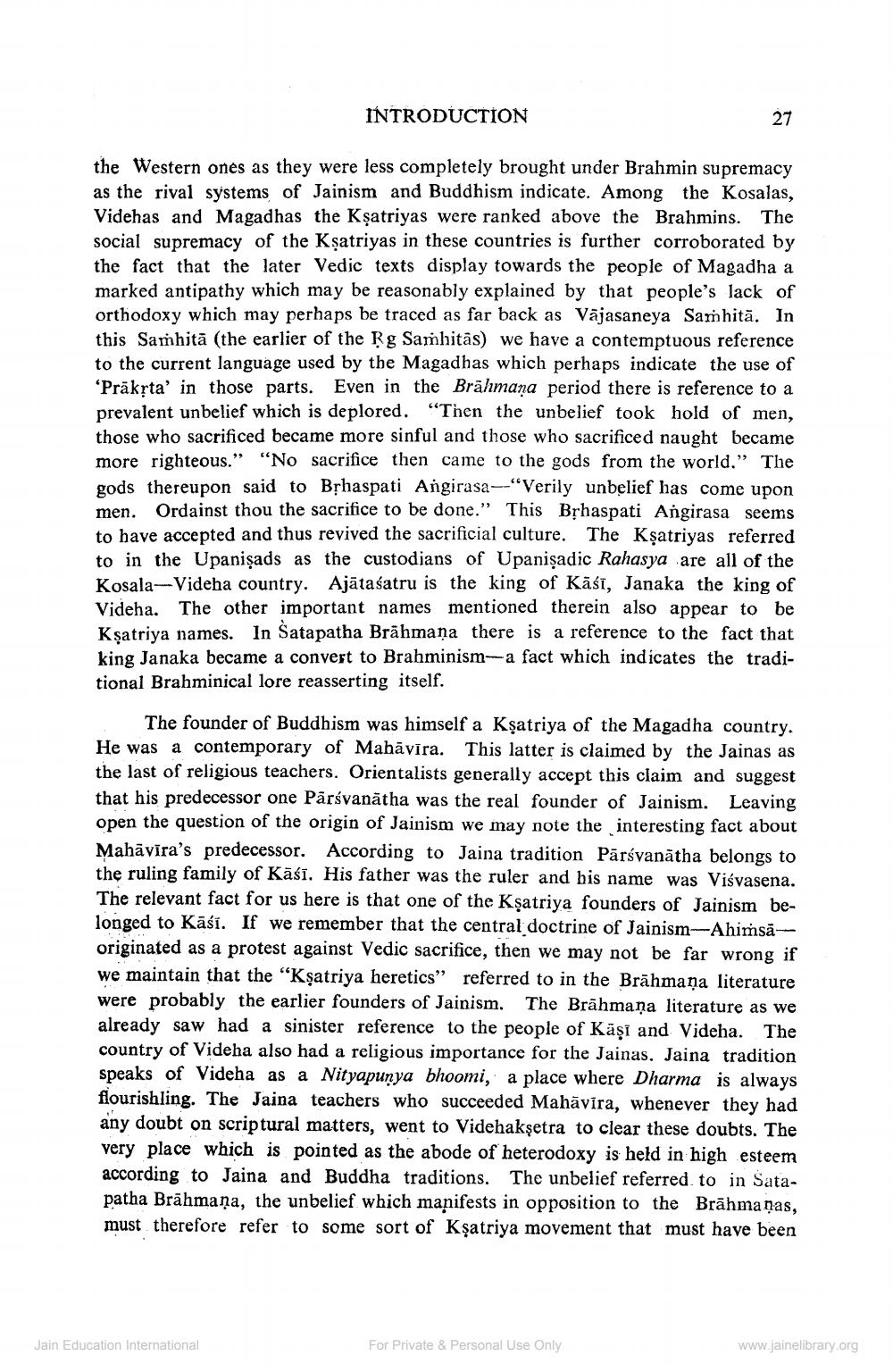________________
INTRODUCTION
27
the Western ones as they were less completely brought under Brahmin supremacy as the rival systems of Jainism and Buddhism indicate. Among the Kosalas, Videhas and Magadhas the Ksatriyas were ranked above the Brahmins. The social supremacy of the Ksatriyas in these countries is further corroborated by the fact that the later Vedic texts display towards the people of Magadha a marked antipathy which may be reasonably explained by that people's lack of orthodoxy which may perhaps be traced as far back as Vājasaneya Samhita. In this Samhitā (the earlier of the Rg Samhitās) we have a contemptuous reference to the current language used by the Magadhas which perhaps indicate the use of ‘Prakrta' in those parts. Even in the Brāhmana period there is reference to a prevalent unbelief which is deplored. “Then the unbelief took hold of men, those who sacrificed became more sinful and those who sacrificed naught became more righteous.” “No sacrifice then came to the gods from the world.” The gods thereupon said to Bșhaspati Angirasa--"Verily unbelief has come upon men. Ordainst thou the sacrifice to be done." This Bịhaspati Angirasa seems to have accepted and thus revived the sacrificial culture. The Ksatriyas referred to in the Upanişads as the custodians of Upanişadic Rahasya are all of the Kosala-Videha country. Ajātaśatru is the king of Kāśī, Janaka the king of Videha. The other important names mentioned therein also appear to be Ksatriya names. In Satapatha Brāhmaṇa there is a reference to the fact that king Janaka became a convert to Brahminism--a fact which indicates the traditional Brahminical lore reasserting itself.
The founder of Buddhism was himself a Kşatriya of the Magadha country. He was a contemporary of Mahāvīra. This latter is claimed by the Jainas as the last of religious teachers. Orientalists generally accept this claim and suggest that his predecessor one Pārsvanātha was the real founder of Jainism. Leaving open the question of the origin of Jainism we may note the interesting fact about Mahavira's predecessor. According to Jaina tradition Pārsvanātha belongs to the ruling family of Käsi. His father was the ruler and his name was Visvasena. The relevant fact for us here is that one of the Ksatriya founders of Jainism belonged to Kāśi. If we remember that the central doctrine of Jainism-Ahimsaoriginated as a protest against Vedic sacrifice, then we may not be far wrong if we maintain that the “Kşatriya heretics" referred to in the Brāhmaṇa literature were probably the earlier founders of Jainism. The Brāhmaṇa literature as we already saw had a sinister reference to the people of Käşi and Videha. The country of Videha also had a religious importance for the Jainas, Jaina tradition speaks of Videha as a Nityapunya bhoomi, a place where Dharma is always flourishling. The Jaina teachers who succeeded Mahavira, whenever they had any doubt on scriptural matters, went to Videhakşetra to clear these doubts. The very place which is pointed as the abode of heterodoxy is held in high esteem according to Jaina and Buddha traditions. The unbelief referred to in Satapatha Brāhmaṇa, the unbelief which manifests in opposition to the Brāhmaṇas, must therefore refer to some sort of Ksatriya movement that must have been
Jain Education International
For Private & Personal Use Only
www.jainelibrary.org




